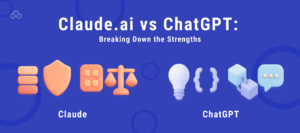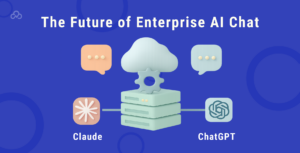Introduction
Artificial intelligence has rapidly transformed from being an exciting experiment to becoming the backbone of all business operations. Every enterprise today is looking at ways to integrate AI into its system. Whether it is customer service, knowledge management, or employee productivity, AI chatbots have found a permanent place in the business world. Two names that constantly dominate the conversation are Claude.ai vs ChatGPT. Both tools have transformed how companies think about automation and engagement. Yet, the main question is not which one is better but why enterprises need a flexible AI chat stack that can bring the strengths of both to the table.
In this blog, let us go into the comparison of Claude.ai vs ChatGPT, and understand the role of business AI chat solutions, and explore how generative AI services and AI as a service models are changing the future of enterprise technology.
The Rise of AI Chat in Enterprises
The past few years have been nothing short of a revolution. Previously, AI chatbots were limited to basic responses and templated answers. But now, with the magic of generative AI services, businesses can handle complex queries to provide customized recommendations, and even write code or create content.
When companies first began experimenting with AI chat, many inclined toward ChatGPT. Its natural tone and ability to handle various queries impressed the enterprises across the world. Soon after, Anthropic introduced Claude, which brought in a new wave of safer, ethical, and highly structured AI responses. This gave rise to the debate of ChatGPT vs Claude, which is still ongoing.
However, while enterprises compare Claude.ai vs ChatGPT, it is becoming clear that the future does not depend on choosing one over the other. But, it lies in building a flexible AI chat that can make use of both depending on the context.
Claude.ai vs ChatGPT: Breaking Down the Strengths

Let us see how these two tools are different and why enterprises may want to use both rather than choose only one.
ChatGPT’s Strengths
1. Excellent for creativity and brainstorming
2. Strong coding capabilities
3. Highly integrated with third-party apps and tools
4. Amazing for conversational flows and customer engagement
Claude’s Strengths
1. Prioritizes safety and ethical AI use
2. Handles large document analysis with ease
3. Excellent for structured responses and business-sensitive tasks
4. Strong focus on enterprise compliance and responsible AI
When businesses use Claude.ai vs ChatGPT, they often find that ChatGPT shines in innovation-heavy tasks, while Claude performs better in compliance-heavy and sensitive operations. And this balance tells why relying only on one tool may block business potential.
Why Enterprises Cannot Rely on Just One Model
Imagine a company that uses ChatGPT highly. It would benefit from creative ideas which helps in rapid coding assistance, and engaging conversations. However, when handling legal documents, financial data, or healthcare records, it may lack strict ethical boundaries that might create issues.
Now imagine another company using only Claude. It would benefit from safe and structured outputs but might feel limited when exploring highly creative use cases or quick customer interactions.
This is why the comparison of Claude.ai vs ChatGPT often misses the bigger picture. Enterprises need to use both models through a flexible AI chat stack.
Business AI Chat Solutions: Beyond Just One Bot
For enterprises, using AI is no longer about testing with a single chatbot. It is about creating business AI chat solutions that can grow across departments like- customer support, marketing, HR, finance, and IT teams all need different kinds of support from AI.
For example:
1. Customer support teams may prefer ChatGPT for fast and natural conversations. Because of its ability to understand the query intent quickly and generate human-like responses makes it ideal for handling large volumes of queries, reducing wait times, and improving customer satisfaction.
2. Legal and compliance teams might depend on Claude for safe and well-structured analysis. With its focus on accuracy, clarity, and risk-free outputs, Claude ensures that sensitive or regulatory content is handled responsibly without compromising compliance.
3. Marketing teams may want generative AI services that go with the creativity of ChatGPT with the discipline of Claude. This blend allows marketers to brainstorm bold, innovative campaigns while still maintaining brand voice, factual accuracy, and ethical standards and creating content that is both engaging and trustworthy.
In each of these scenarios, the magic lies in integration. By creating a flexible AI chat stack, companies can pick and choose which model works best for a particular scenario. And this flexibility is the future of business AI chat solutions.
Generative AI Services: Fueling the Transformation
One of the biggest reasons behind the success of ChatGPT vs Claude comparisons is the growth of generative AI services. These services allow enterprises to automate content creation, streamline decision-making, and enhance productivity.
For example, generative AI can help businesses to:
– Draft reports in minutes
– Summarize hours of meeting transcripts
– Generate marketing campaigns
– Create personalized customer journeys
Both ChatGPT and Claude contribute to these outcomes. Together, they cover a wide range of enterprise needs. Enterprises that understand this and design their AI chat stack accordingly gain a clear competitive advantage.
AI as a Service: Making AI Accessible
Another important part in the conversation of Claude.ai vs ChatGPT is the rise of AI as a service. Instead of building massive AI models from ground zero, companies now can access ready-to-use solutions. Cloud providers, SaaS companies, and AI startups are offering packaged AI solutions that can be integrated into existing work-systems and make your work easier.
With AI as a service, enterprises can test with different models without reserving themselves into one. This flexibility makes it easier to run ChatGPT vs Claude comparisons in real business settings and choose the right model for the right use of your organisation.
Real-Life Examples of a Flexible AI Chat Stack
Let us look at some scenarios where enterprises can benefit from a flexible AI stack:
1.Banking
– ChatGPT handles customer FAQs and loan inquiries.
– Claude analyzes compliance documents and risk assessments.
2. Healthcare
– ChatGPT engages patients with friendly communication.
– Claude reviews medical documentation for compliance and accuracy.
3. E-commerce
– ChatGPT creates product descriptions and marketing campaigns.
– Claude reviews return policies and ensures customer data privacy.
In each case, enterprises that rely only on one model risk missing out on the combined strengths.
The Future of Enterprise AI Chat

As enterprises continue to debate Claude.ai vs ChatGPT, the future points toward hybrid adoption. Just as companies use multiple cloud providers for resilience, they will use multiple AI models for flexibility.
The next phase of business AI chat solutions will focus on orchestration. Enterprises will not just ask, “Should we use ChatGPT vs Claude?” Instead, they will ask, “How do we use ChatGPT and Claude together?”
Orchestration platforms that combine generative AI services with AI as a service offerings will become the foundation of enterprise AI strategies. Businesses that adopt this approach will have the freedom to innovate while ensuring compliance and safety.
FAQs
1. What is the difference between Claude.ai vs ChatGPT?
Claude is designed with a focus on safety and compliance, while ChatGPT is known for creativity and coding support. And most importantly enterprises benefit by using both of them together.
2. Which is better for business AI chat solutions, ChatGPT or Claude?
It depends on the use case. ChatGPT is great for creative and customer-facing tasks, while Claude is ideal for compliance-heavy and sensitive work.
3. How do generative AI services help enterprises?
Generative AI services automate content creation, streamline workflows, and enhance decision-making, saving time and resources for businesses.
4. What role does AI as a service play in enterprise AI adoption?
AI as a service allows companies to access AI models like ChatGPT and Claude without building them in-house, making adoption cost-effective and scalable.
5. Can enterprises rely on just one AI chatbot?
Relying on just one chatbot can create gaps. But a flexible AI chat stack using both ChatGPT and Claude is more effective.
6. How should companies approach ChatGPT vs Claude in 2025?
Instead of going with the one, companies should integrate both into their workflows to use each of them for its strengths.
Conclusion
The debate of Claude.ai vs ChatGPT has generated a lot of interest in the market, but the truth is enterprises do not need to pick any one side. The future lies in building a flexible AI chat stack that combines both work-systems. With business AI chat solutions, generative AI services, and AI as a service, companies can see new possibilities.
Rather than asking which is better, enterprises should ask how to make the most of the benefits using both. In a world where agility and adaptability define success, the smartest move is to create an AI ecosystem where Claude and ChatGPT work together to deliver the best results.
Do you like to read more educational content? Read our blogs at Cloudastra Technologies or contact us for business enquiry at Cloudastra Contact Us.